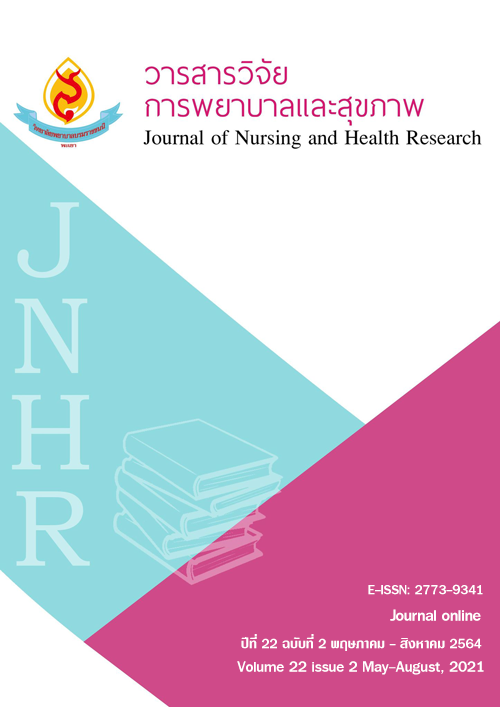ผลการใช้แนวปฏิบัติทางการพยาบาลเพื่อป้องกันภาวะตกเลือด 2 ชั่วโมงหลังคลอด
คำสำคัญ:
แนวปฏิบัติทางการพยาบาล, ภาวะตกเลือดหลังคลอด 2 ชั่วโมง, ภาวะแทรกซ้อนหลังคลอดบทคัดย่อ
การวิจัยครั้งนี้มีวัตถุประสงค์เพื่อศึกษาผลการใช้แนวปฏิบัติทางการพยาบาลเพื่อป้องกันภาวะตกเลือด 2 ชั่วโมงหลังคลอดต่อการเกิดภาวะตกเลือดหลังคลอด และภาวะแทรกซ้อนหลังคลอด และศึกษาความเป็นไปได้ของการนำแนวปฏิบัติทางการพยาบาลไปใช้ และความพึงพอใจของพยาบาลแผนกห้องคลอด โรงพยาบาลพะเยา ต่อการใช้แนวปฏิบัติทางการพยาบาลเพื่อป้องกันการตกเลือด 2 ชั่วโมงหลังคลอดรูปแบบการศึกษาเป็นการวิจัยกึ่งทดลองชนิด 2 กลุ่มเปรียบเทียบคนละช่วงเวลา (Interrupted time design) ประชากรประกอบด้วย 1) หญิงตั้งครรภ์ที่คลอดปกติ โดยกลุ่มควบคุมได้รับการดูแลตามแนวปฏิบัติแบบเดิมตั้งแต่กันยายน 2562 ถึงเดือนมกราคม 2563 และกลุ่มทดลองได้รับการดูแลตามแนวปฏิบัติทางการพยาบาลที่พัฒนาขึ้น ตั้งแต่เดือนกันยายน 2563 ถึงมกราคม 2564 จํานวน 396 คน และ 2) พยาบาลวิชาชีพปฏิบัติงานในห้องคลอด จํานวน 9 คน แบบประเมินความเป็นไปได้ในการนำแนวปฏิบัติไปใช้ และแบบประเมินความพึงพอใจของพยาบาล ผ่านการตรวจสอบความเที่ยงตรง โดยประเมินความสอดคล้องของข้อคำถามกับวัตถุประสงค์ (IOC) โดยผู้เชี่ยวชาญทางสูติกรรม จำนวน 5 ท่าน (IOC เท่ากับ 0.80-1) ประเมินคุณภาพของแนวปฏิบัติที่พัฒนาขึ้น โดยใช้แบบประเมิน Appraisal of Guideline for Research & Evaluation II ได้คะแนนในแต่ละหมวดมากกว่าร้อยละ50 วิเคราะห์ข้อมูลโดยนำเสนอค่าความถี่ ร้อยละ ค่าเฉลี่ย ส่วนเบี่ยงเบนมาตรฐาน ทดสอบความแตกต่างโดยใช้ exact probability test และ chi-square และวิเคราะห์ผลการใช้แนวปฏิบัติทางการพยาบาล เพื่อป้องกันการตกเลือดหลังคลอดโดยใช้ relative risk regression ผลการศึกษาพบว่า กลุ่มทดลอง มีอุบัติการณ์ตกเลือดหลังคลอด ต่ำกว่ากลุ่มควบคุม อย่างมีนัยสำคัญทางสถิติ (p=0.01) เมื่อวิเคราะห์ relative risk regression พบว่าการใช้แนวปฏิบัติทางการพยาบาลเพื่อป้องกันการตกเลือด 2 ชั่วโมงหลังคลอด ลดการตกเลือดหลังคลอดได้ร้อยละ 77 (RR 0.23, 95% CI 0.07-0.71, p=0.01) การเปรียบเทียบผลลัพธ์การเกิดภาวะแทรกซ้อนด้านการตัดมดลูกและภาวะช็อคของ หญิงตั้งครรภ์ระหว่างกลุ่มควบคุมกับกลุ่มทดลอง พบว่า มีความแตกต่างกันอย่างไม่มีนัยสำคัญทางสถิติ ด้านความเป็นไปได้ของการนำแนวปฏิบัติไปใช้ในห้องคลอดมีความเหมาะสม ร้อยละ 95.45 ความพึงพอใจของพยาบาลแผนกห้องคลอดต่อการใช้แนวปฏิบัติทางการพยาบาลเพื่อป้องกันการตกเลือด 2 ชั่วโมงหลังคลอด พบว่ามีความพึงพอใจในระดับดี (mean=4.20, SD.=0.67)
เอกสารอ้างอิง
กรมการแพทย์ กระทรวงสาธารณสุข. (2558). คู่มือเวชปฏิบัติการคลอดมาตรฐาน. กลุ่มงานพัฒนานโยบายและยุทธศาสตร์การแพทย์ กระทรวงสาธารณสุข.
กรรณิการ์ ทุ่นศิริ. (2556). ผลการเรียนรู้แบบมีส่วนร่วมต่อการพัฒนาแนวปฏิบัติการพยาบาลเพื่อป้องกันการตกเลือดหลังคลอดในเครือข่ายงานอนามัยแม่และเด็กจังหวัดศรีสะเกษ. วารสารสมาคมพยาบาลฯ สาขาภาคตะวันออกเฉียงเหนือ, 31(4), 115 - 120.
กองยุทธศาสตร์และแผนงานสำนักงานปลัดกระทรวงสาธารณสุข. (2562). สถิติสาธารณสุข พ.ศ. 2562 สำนักงานปลัดกระทรวงสาธารณสุข.
ณฐนนท์ ศิริมาศ, ปิยรัตน์ โสมศรีแพง, สุพางค์พรรณ พาดกลาง และจีรพร จักษุจินดา. (2557). การพัฒนาระบบการดูแลหญิงตั้งครรภ์ในการป้องกันภาวะตกเลือดหลังคลอดในโรงพยาบาลสกลนคร. วารสารการพยาบาลและการดูแลสุขภาพ, 32(2), 37 - 46.
นันทพร แสนศิริพันธุ์ และฉวี เบาทรวง. (2561). การพยาบาลและการผดุงครรภ์ : สตรีที่มีภาวะแทรกซ้อน. (พิมพ์ครั้งที่ 2). เชียงใหม่: สมาร์ทโคตติ้ง เอนด์ เซอร์วิส.
นววรรณ มณีจันทร์ และอุบล แจ่มนาม. (2559). ศึกษาประสิทธิผลของการใช้แนวปฏิบัติการพยาบาลทางคลินิกเพื่อป้องกันการตกเลือดหลังคลอดในระยะแรก โรงพยาบาลราชบุรี. วารสารวิชาการแพทย์ เขต 11, 31(1), 143-155.
ปทุมมา กังวานตระกูล และอ้อยอิ่น อินยาศร. (2560). การพัฒนาแนวปฏิบัติการพยาบาลเพื่อป้องกันการตกเลือดในระยะ 2 ชั่วโมงแรกหลังคลอดในห้องคลอด โรงพยาบาลอุดรธานี. วารสารวิทยาลัยพยาบาลบรมราชชนนี กรุงเทพ, 33(2), 121-134.
ประภาพร ดองโพธิ์. (2558). ประสิทธิผลของการใช้แนวปฏิบัติทางคลินิกสำหรับป้องกันการเกิดแผลกดทับ. รายงานการวิจัยโรงพยาบาลธรรมศาสตร์เฉลิมพระเกียรติ. สืบค้นเมื่อ 1กันยายน 2563 จาก http://portal.nurse.cmu.ac.th/jbicmu/.
พิมลพันธ์ เจริญศรี, วาสนา สารการ และบาลิยา ไชยรา. (2560). การพัฒนารูปแบบการพยาบาลหญิงตั้งครรภ์ เพื่อป้องกันภาวะตกเลือดหลังคลอดระยะแรกในโรงพยาบาลสรรพสิทธิประสงค์. วารสารการพยาบาลและการดูแลสุขภาพ, 35(3), 48-57.
ลัดดาวัลย์ ปลอดฤทธิ์, สุชาตา วิภวกานต์, และอารี กิ่งเล็ก. (2559). การพัฒนาแนวปฏิบัติการป้องกันการตกเลือดหลังคลอดระยะแรกในห้องคลอดโรงพยาบาลกระบี่. วารสารเครือข่ายวิทยาลัยพยาบาลและการสาธารณสุขภาคใต้, 3(3), 127-141.
เวชระเบียนห้องคลอด โรงพยาบาลพะเยา. (2560-2562). สรุปรายงานการคลอดปีงบประมาณ 2560 - 2562: โรงพยาบาลพะเยา.
ศิริวรรณ ช่วยรักษา. (2559). การพัฒนาระบบการป้องกันภาวะตกเลือดหลังคลอด ในโรงพยาบาลนามน อําเภอนามน จังหวัดกาฬสินธุ์. รายงานการวิจัยโรงพยาบาล. สืบค้นเมื่อ 10 กันยายน 2563 จาก http://portal.nurse.cmu.ac.th/jbicmu/.
ศิริโสภา คำเครือ, ทัศนีย์ ศรีสุวรรณ, และรุณราวรรณ์ แก้วบุญเรือง. (2561). การพัฒนาแนวปฏิบัติ การป้องกันภาวะตกเลือดหลังคลอดระยะแรกในห้องคลอด โรงพยาบาลลำพูน. วารสารการส่งเสริมสุขภาพและอนามัยสิ่งแวดล้อมล้านนา, 8(1), 46-57.
FIGO. (2018). PPH-leading-unnecessary-deaths. Retrieved December 16, 2020, From https://www.figo.org/news/pph-leading-unnecessary-deaths.
Pillitteri, A. (2007). Maternal & child health nursing care of the childbearing & childbearing family. (5th ed). Philadelphia: Lippincott Williams & Wikins. Population Division: Retrieved October 16, 2020, From https://apps.who.int/iris/ bitstream/10665/112682/2/9789241507226_eng.pdf?ua=1.
World Health Organization. (2020). WHO recommendation on routes of oxytocin administration for the prevention of postpartum haemorrhage after vaginal birth. Retrieved December16, 2020, From https://www.who.int/publications/i/item/9789240013926/
ดาวน์โหลด
เผยแพร่แล้ว
รูปแบบการอ้างอิง
ฉบับ
ประเภทบทความ
สัญญาอนุญาต
ลิขสิทธิ์ (c) 2021 วารสารวิจัยการพยาบาลและสุขภาพ

อนุญาตภายใต้เงื่อนไข Creative Commons Attribution-NonCommercial-NoDerivatives 4.0 International License.



